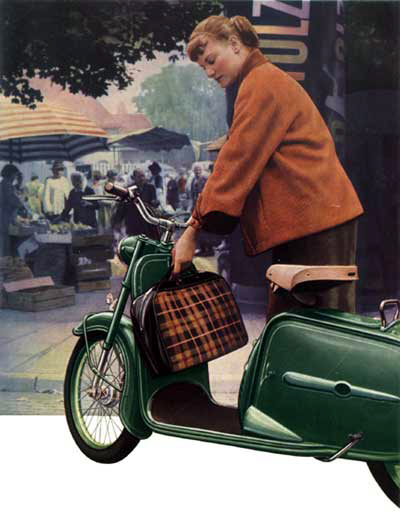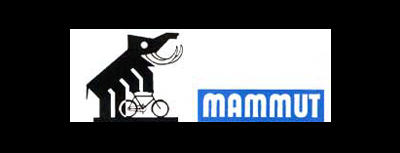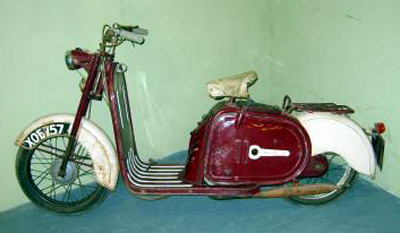PAGE 45. German Cyclemotors: 1952 Steppke on Meister Bicycle; Meister Solo-Roller
Meister Cycle with 1952 Steppke 38cc engine
Steppke engines were built in the Treptow Machine Tools factory in East Berlin.
The Steppke was East Germany’s second most popular auxiliary engine, and its style is reminiscent of the Mosquito and the Lohmann.
East German engineers apparently studied the Mosquito before designing the Steppke.
The engine has a good reputation for reliability and strength, and it’s easy to use the lever (similar to the Lohmann) to locate the engine roller onto the tyre.
The Steppke is not particularly rare in Germany, but in France and Britain it is virtually unknown. Possibly, even if they’d come across a Steppke, rather than own an East German copy of a Mosquito, a British collector would prefer to own the real thing.
However, they are excellent utilitarian cycle-attachment units in their own right …and anyway I already have a Mosquito!
This engine and bicycle was restored for me by my friend Pat in France. I really like the Meister brand (see my extensive review of its cyclemotor output below) and I think the Steppke and the Meister go very well together. Thanks, Pat!
*************************************************************************************
Meister Cyclemotor History
Meister had an interesting history of cycle-attachment engines. Above is the 1951 Meister bicycle with a Küchen ‘help-engine’ which was marketed in Sweden.
The advert below illustrates the 1953 Meister Junior – which could also be purchased as a Mammut Bimbo or a Phänomen Bobby.
What quaint names! ‘Mammut’ is actually the German word for ‘mammoth.’ Can you imagine riding a ‘Mammoth Bimbo’ motorcycle in 2008? I’m going to search for one just because I so like the name.
But of more significance, note the ‘pre-moped’ styling, ie the petrol tank under the seat, and a style that obviously does not disguise its bicycle origins. These old-fashioned Junior, Bimbo and Bobby cyclemotors were just a year away from the launch of the NSU Quickly and hundreds of similar ‘modern’ moped models across Europe – which would instantly make our dearly-beloved cycle-attachment models obsolete. Do you think it’s the ‘innocence’ of the Bimbo and its ilk that is a major element of our attraction?
In 1954, Meister replaced the Junior with the Saxoni, seen in the poster above. This is a perfect example of the minor styling changes that turn a cyclemotor into a moped. Compare the two pictures. The petrol tank is now forward and there’s a full chain-case. The bicycle appears to have slightly wider wheels and tyres, but apart from that it appears to be the same frame.
Just as the ‘Junior’ was replaced by the ‘Saxoni’ the names ‘Bimbo’ and ‘Bobby’ have meanwhile been relegated to the history books, as the badged versions now sport much more adult names – the Mammut Tourist and the Phänomen Fix.
*************************************************************************************
1953 Mammoth Bimbo v 1954 Mammoth Tourist
Manufactured by Mammut-Vertriebsges, of Bielefeld
Because these 2 models epitomize the difference between cyclemotors and mopeds, here’s a special extra section for the Mammut models.
Actually, I’ve fallen in love with the name ‘Mammoth Bimbo’ while I’ve been researching writing this article. I’m having some serious problems with the incongruous mental image of an oversize bimbo hairy elephant cyclemotor.
So here is a further comparison of them, with added technical data. Note that the earlier version used a JLO motor, while the replacement model a year later featured the Sachs engine.
Mammut-Bimbo 1953
Mammut-Bimbo 1953
Engine: Air-cooled two-stroke single-cylinder JLOMotor FP-50, Bohrunq 38 mm 43 mm stroke, 49 cc engine capacity, compaction 1:8,5, performance 1.5 hp at 5200 rpm., Bing-carburetor 1/11/1 .
Electrical system: light flywheel magneto 6 V, 16.5 W. headlights, rear lights, electric. Horn (Aufpreis). Horn (surcharge).
Transmission: A-speed, steel slats clutch, roller chain on the rear wheel.
Chassis: Rubber front fork, rear fork with failure shoes.
Enamel: black.
Tyres: Balloon 26×2, 00
Fuel tank: Contents 2.6 Ltr
Standard fuel consumption: Ltr./100 approximately 1.2 km.
Weight: 30 kg.
Mammut-Tourist 1954
Mammut-Tourist 1954
Engine: 2-stroke single Sachs’ engine, 38 mm bore, 42 mm stroke, 48 cc Engine capacity.
Power at 4100 rev / min. = 1,25 PS. Hp = 1.25.
Built with light flywheel igniter Appendix 6 volts, 3.3 watts.
Cork disk clutch, 2-speed transmission with Twist circuit from the handlebars.
Frame: Central tube frame.
Brakes: Novel failure shoes facilitate the dismantling.
Separate fender and luggage carrier.
‘Meister-Silastic-Gabel’ – forks with 50 mm elastic spring, using shaped rubber body so totally maintenance-free.
Aprons particularly robust, 70 mm wide, extra long front plate and with side protection.
Wheels 25×2, 00 balloon, with a reinforced front F. & S. Rear with F. & S. and 2.65 mm thick spokes.
Chain Dimensions 1 / 2 “x3/16×7, 8 roller diameter x98 limbs.
Other equipment: engine stored in rubber. Chassis 3-fold enamelled. Fuel tanks with 3 litres, guaranteed denser tank closure.
Broad and deep chain box, carburetor side room disguises. Racks with spring-loaded mounting bracket. Tension and compression springs; air pump, signal bell, electric rear lights, lock plate frame soldered.
Extras: headlamps with 2.7 watt bulb and switch. In headlights with integrated tachometer odometer, theft protection; other paint colours also available.
Top speed about 35 km / hr
Fuel consumption about 1.2 litres per 100 km.
Dimensions: 1190 mm wheelbase, overall length 1900 mm, width 650 mm overall, the lowest seat height 770 mm, weight 33 kg (dry and without accessories).
*************************************************************************************
The MEISTER-Silastic-fork
The MEISTER-Silastic-fork is clear and simple in construction.
(Key to illustration on left).
The specific to the fork crown upper part (a) and sub-section (b) is occurring according to the Bean spruchungen formed and provides virtually trapezarfige two cross sections dar.
The strong dimensioerten ball screws (d) bring the rubber block to a certain degree and are protected by maggots per barrel (s) secured against torsion.
One lid storage of ball screws in the upper Fork head is special consideration.
[apologies for the poor translation, but I do not speak German and have to rely on internet translation services – which regularly supply unintelligible translations such as above. Nevertheless, I did find the ‘maggots per barrel’ an interesting concept]
*************************************************************************************
*************************************************************************************
Meister-Werke, Erhard Doppelt, Bielefeld
Pre-war Meisters also featured a version of the cycle-attachment engine, ie the 98cc Fichtel & Sachs unit that was fitted to so many German manufacturers’ lightweight models in the thirties. The 1940 Meister pictured here (for sale on German ebay as a restoration project) is a 1940 model.
*************************************************************************************
Meister Mopeds
By 1955, Meister had updated their machines sufficiently to compete with other mopeds. The table above illustrates their model range year by year.
Above is the 1955 Meister M 45/3, badged also, as before, by Mammut (with model name 245/3, pictured below) and Phänomen as a 67/3. As you can see, the 1955 models now sport telescopic front forks, but no rear suspension.
Here’s a real one, advertised on German ebay for restoration
Rear suspension was added to the 1956 model, the Meister 45F (below). An uprated standard version, the M45F was produced between 1957-58.
*************************************************************************************
1957 Meister Super-Luxus
Offered at the same time was a very attractive fully-enclosed model, the Meister Super-Luxus Type M 45 SL. It’s featured on the front cover of the 1956 ‘Das Moped’ magazine (above) to publicize its launch, and illustrated in the poster below.
And here’s the Mammut version, the Type 245 SL (Super Luxury). The poster, however, is rather odd – it’s rare that you see a motorcycle advertised with cloudy rain-threatening skies in the background. The yound lady rider appears somewhat apprehensive about whether to risk riding the moped.
Please excuse another dodgy translation, of Mammut’s advert for the Super Luxury:
“A” class moped – MAMMUT
It will inspire everyone whose wise attitude to the concept of quality not half wish.
They are also full of pride at this point, and advanced vehicle with soothing pleased to note that you have chosen correctly.
Their weitgrefend Ansprücke find fulfilled:
In the sleek, chrome rings decorated with a full-Karossierung that you and your machine best dirt protection,
In the elastic – and maintenance – front and rear wings suspension,
In the adjustable vibration damping of the latest findings developed front-fork,
In the new, for your personal safety so infinitely important 15-watt lighting system,
Hubs in the full brakes, chrome wheels, and also for long trips especially practical 6.5 Ltr tank with 1 Ltr Reserve, in the modern luggage carrier with dual clamping rubber strap,
In the elegant white-wall tires, super-balloon 23×2, 25 with Schrader valves to Preßlutfüllung at filling stations, in the compelling dual coating reseda / cream,
By because of its unsurpassed reliability in the world famous 50-cc two-SACHS gear motor.
*************************************************************************************
The Meister Super-Luxus would have been on offer before the 1958 NSU Quickly Model L, which looks very similar; I wonder if the Super Luxus prompted NSU to launch their Model L? Here’s the NSU, below, for comparison.
*************************************************************************************
Meister Solo Roller
And finally we come to Meister’s little scooters. The Solo-Roller was introduced in 1955.
The 1955 Solo Mammut-Roller (below) sported the same 50cc Sachs engine.
Below you have a better view of the accessories on offer.

As with the mopeds, women feature prominently in the adverts: obviously this was the prime market for mopeds and scooters in the fifties.
*************************************************************************************
1956 Mercury Hermes Scooter
See Page 57 for the British version of the Meister Solo Roller, the Mercury Hermes.
































